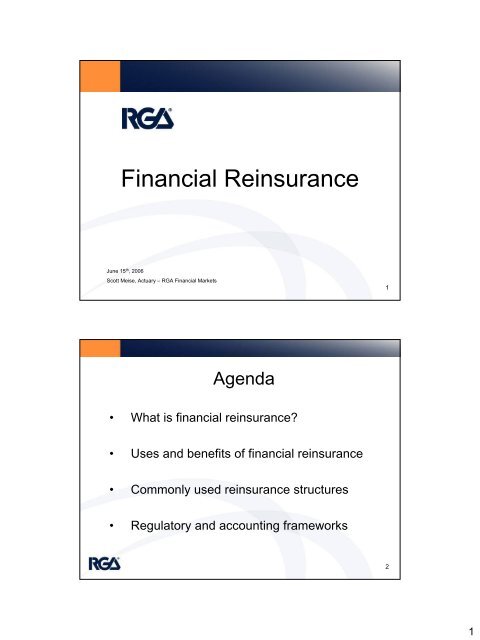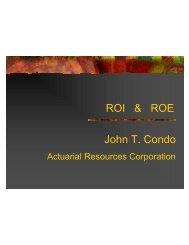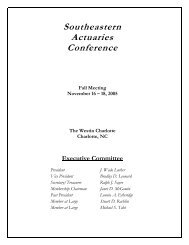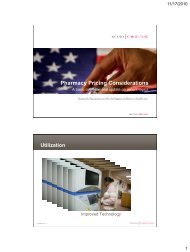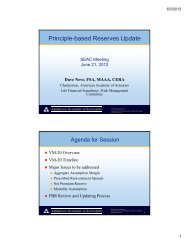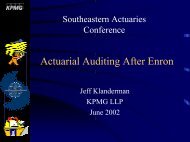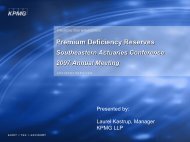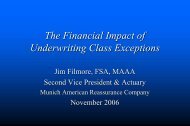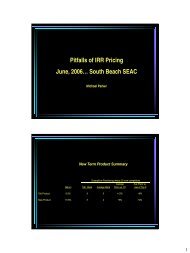Financial Reinsurance
Financial Reinsurance
Financial Reinsurance
- No tags were found...
Create successful ePaper yourself
Turn your PDF publications into a flip-book with our unique Google optimized e-Paper software.
<strong>Financial</strong> <strong>Reinsurance</strong>June 15 th , 2006Scott Meise, Actuary – RGA <strong>Financial</strong> Markets1Agenda• What is financial reinsurance?• Uses and benefits of financial reinsurance• Commonly used reinsurance structures• Regulatory and accounting frameworks21
What is <strong>Financial</strong> <strong>Reinsurance</strong>?3What is <strong>Financial</strong> <strong>Reinsurance</strong>?• Every reinsurance transaction, regardless ofwhether it is YRT, Coinsurance, ModifiedCoinsurance or a combination of the above,will impact both the ceding company and thereinsurer financially.• The primary objective of fin re is theachievement of a specific business goal.42
Typical Business Goals• Improve the level and timing of earnings• Improve the stability of earnings• Improve the level of IRR, ROE, etc.• Assist in financing acquisitions or joint ventures• Efficient tax management• Efficient allocation of income or capital betweenentities<strong>Reinsurance</strong> can help with all of the above5<strong>Financial</strong> <strong>Reinsurance</strong>:Mitigating Risk on a ContinuumFinancing(Lower economic risk,debt-like cost)“<strong>Financial</strong> <strong>Reinsurance</strong>”Risk <strong>Reinsurance</strong>(Higher economic risk,equity-like cost)“Asset-Intensive<strong>Reinsurance</strong>”63
Defining <strong>Financial</strong> <strong>Reinsurance</strong>• <strong>Financial</strong> <strong>Reinsurance</strong> is specificallydesigned to help an insurer manage itscapital and statutory earnings by passing riskand the associated capital strain to thereinsurer.• <strong>Financial</strong> reinsurance is not a loan. Thereinsurer can recover its capital only from thefuture profits of the reinsured block.7Uses and Benefits of<strong>Financial</strong> <strong>Reinsurance</strong>84
Uses and Benefits of <strong>Financial</strong><strong>Reinsurance</strong>• Accelerate statutory earnings to shareholders.• Reimburse ceding company’s acquisition costs,thereby reducing capital strain.• Reduce required RBC and / or increase cedingcompany capital.• Support the growth of new business.• Higher ROEs, through capital leverage.• Attract capital / financing without compromisingownership.• Develop expertise in new product areas.9Alternatives to <strong>Financial</strong><strong>Reinsurance</strong>• Equity• Subordinated Debt• Contingent Debt• Surplus Notes• Hybrid Securities• Securitization105
Advantages of <strong>Financial</strong><strong>Reinsurance</strong>• The Reinsurer is on risk.• Capital leverage is more effective than other forms offinancing as reinsurance can both:– Reduce required reserves and/or RBC.– Provide capital through a ceding allowance.• Rapid implementation, Confidentiality and Simplicity.• Competitive Pricing / Low Transaction Costs.• Access to Reinsurer’s expertise.• Flexibility of size, structure, and / or duration.11Commonly Used <strong>Reinsurance</strong>Structures126
Forms of <strong>Reinsurance</strong>• YRT• Coinsurance• Coinsurance/Funds Withheld• Modified Coinsurance• Co/Modco, Co/CFW and Co/Modco/CFWalso possible– The % split between Coinsurance and Modco/CFW canchange over time– Can be designed so that cash flows between cedingcompany and reinsurer are minimized13Examples of <strong>Financial</strong><strong>Reinsurance</strong>• Relief of redundant statutory reserves– XXX / AXXX– Deficiency / tax overhang reserves• Acquisition cost financing– Either cash or non-cash• Risk-based capital relief147
How Is This Done?• Use economic expectations rather thanstatutory valuation to:– Replace conservatism in actuarial valuation withcompetitive reinsurance rates.– Stabilize future earnings by reducing risk.15Regulation, Accounting and Tax168
<strong>Financial</strong> <strong>Reinsurance</strong> Regulation• NAIC Model Regulations passed in 1985 and1992, following NY and CA.– Regulations say both what must and what can’t bedone.– Control is denial of ceding company reserve credit.• Regulations were in response to perceivedabuses.• All significant risks must be transferred forceding company to receive reserve credit.• “Significant” risks are identified by product.17Statutory / Tax Accounting• “All or nothing” statutory reserve credit• Controlled by risk transfer regulation• More detail in Appendix A-791• Section 845 prohibits transactions with“significant tax avoidance effect.”• The Model Regulation sets the standard• Recognized by courts in Trans-City decision189
GAAP Accounting• Limited discussion in FAS 60.• FAS 113 addresses in more detail.– Treat as reinsurance if:• Reinsurer assumes significant risk, and• Reasonable possibility of significant loss, or• All of insurance risk transferred• Deposit accounting used for transactions notdeemed to be reinsurance.19Questions?2010


